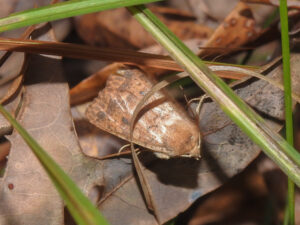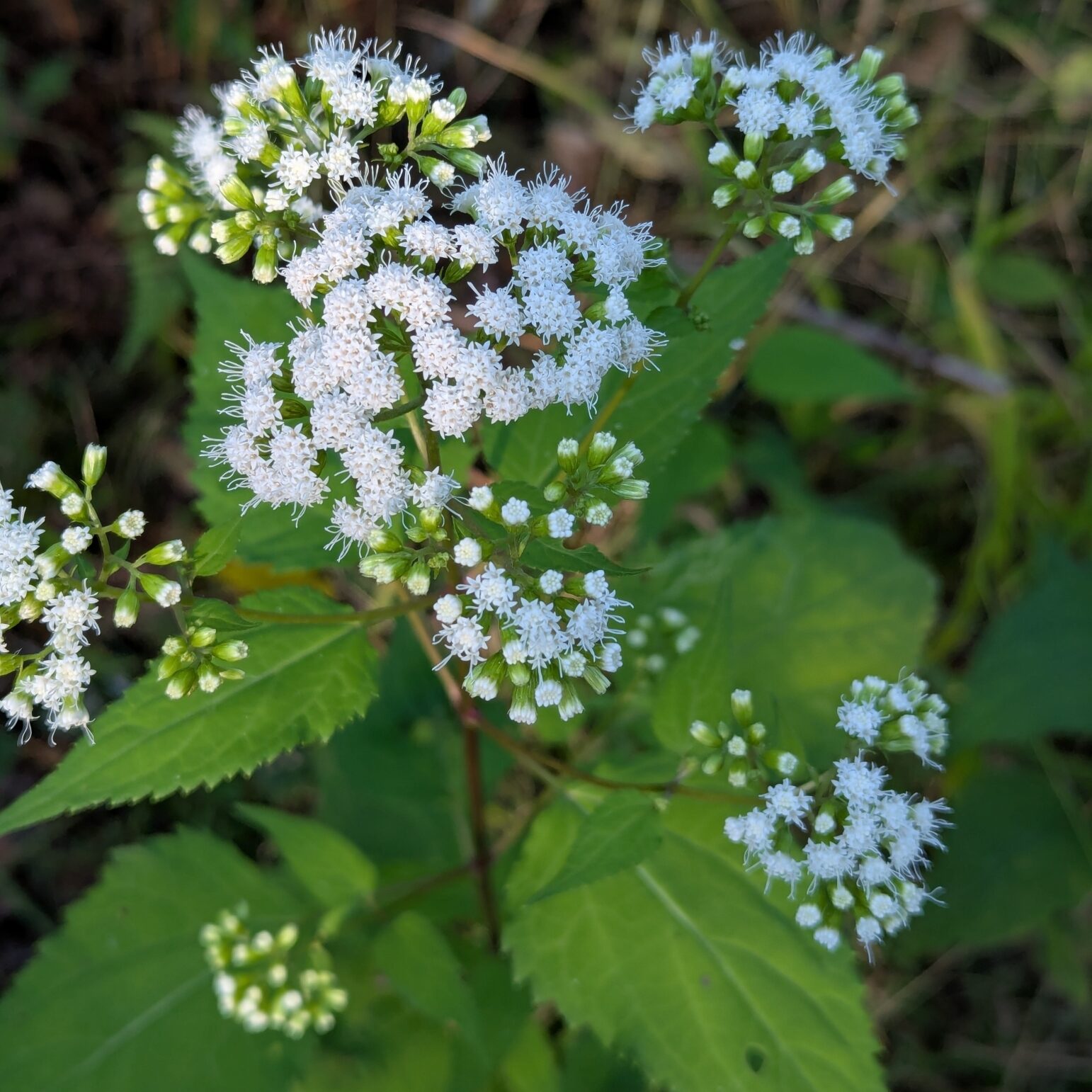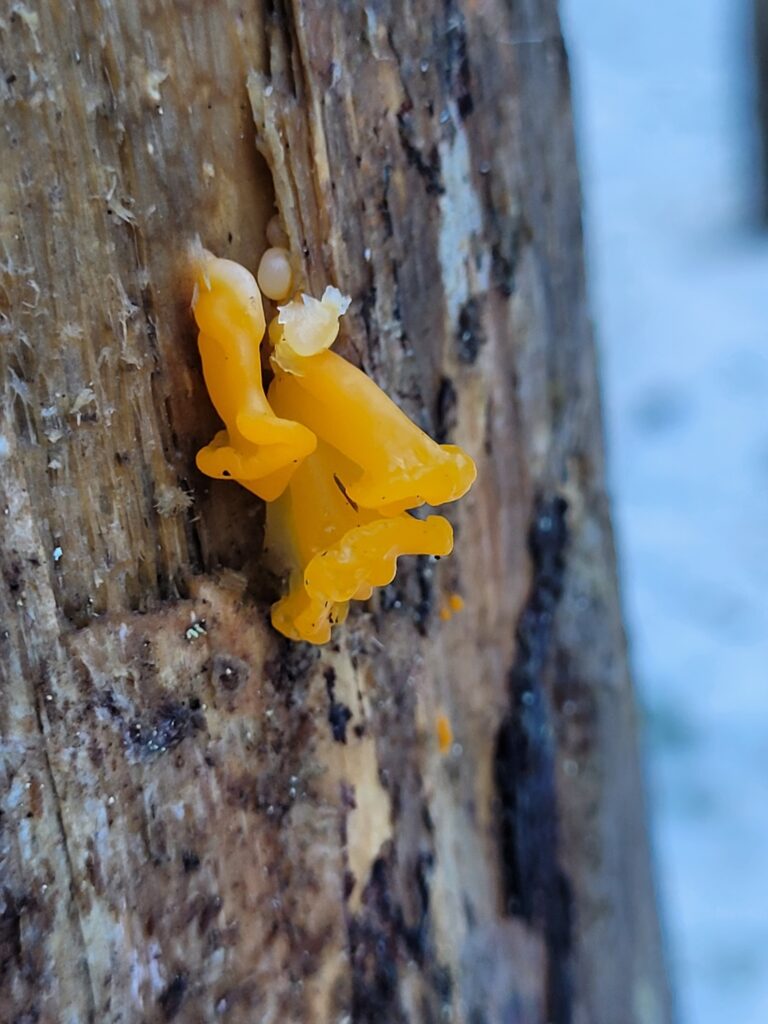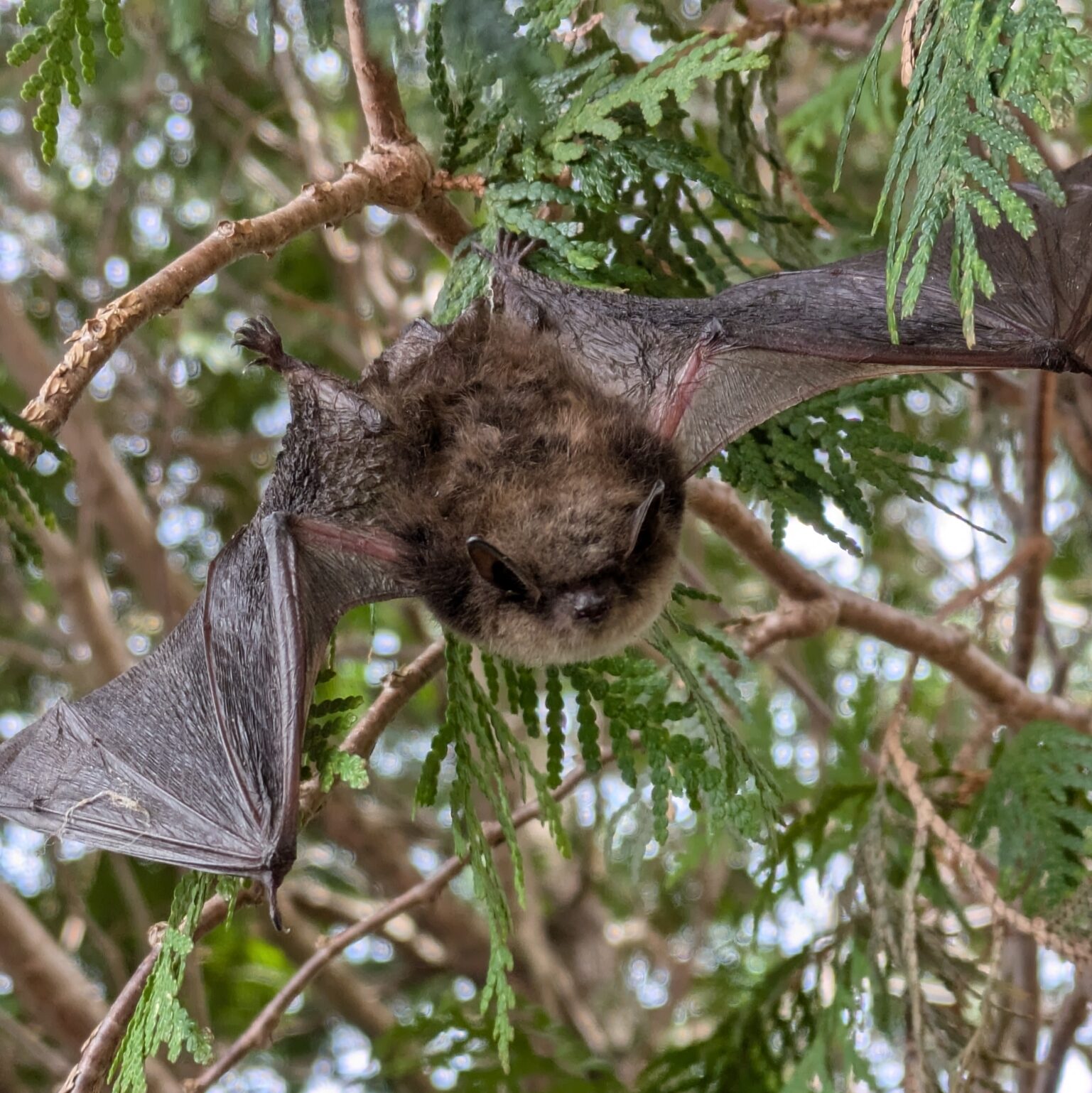by Katherine Garvey ✎
As the sun dips behind the city skyline and beyond county houses, as the air cools and the light dims, Baltimore’s gardens don’t go to sleep. Not yet, anyway. Instead, the night shift wakes up. After the last bees and butterflies find their evening hidey-holes, the flutter of moths, rustle of toads, and faint glow of fungi take their place.
This Halloween, as we deck our porches with paper ghosts and plastic cobwebs, let’s not forget the real magic that happens after sundown: our gardens become haunted with the forgotten creatures and plants of the dark.
Moths, Bats & Twilight Critters

Charismatic butterflies commonly act as the mascot of the Lepidoptera family, but moths are just as important, and arguably just as beautiful. They are the unsung pollinators of our region, and are as necessary as bees for a complete garden habitat. In late summer and into early fall, noctuid moths such as bicolored sallows (Sunira bicolorago), celery and bilobed loopers (Anagrapha falcifera and Megalographa biloba), and the ubiquitous green cloverworm moth (Hypena scabra) flit between the last blooms of the season, including common evening primrose and late boneset, where flowers yet linger among sheltered Baltimore gardens.
Blooming has mostly ended for the season, much to the chagrin of nature lovers everywhere, but pollinators still need food sources. Moths in particular will continue to feed on what remains, such as asters and white snakeroot, or even overripe fruit from missed apple trees. The next generation of moths, just starting off their lives as pupae, are being buried in leaf litter as those same trees sink into their winter slumber. When the pupae emerge in the spring, many will become food for young songbirds.
And what of bats, the ultimate Halloween icon? Even though Maryland’s bats are insectivores, not nectar-feeders, they are still heroic critters that depend on our gardens for food. One little brown bat (Myotis lucifugus) can easily eat hundreds of mosquitoes in an hour, making them vanquishers of the daytime vampires that are the bane of every gardener! Bats require more than just mosquitoes, however, and that is what our gardens provide: a diverse bug-buffet thanks to our nighttime blooms. Native landscapes are especially helpful since most concerned gardeners keep pesticide-free, organic habitats. Little brown bats are a vulnerable species, and food that is free from pesticides can help keep their populations strong.
Other animals have taken up the graveyard shift as well. Crickets and katydids chirp and chatter, their songs slowing to provide the perfect tempo for a chilling garden. American toads (Anaxyrus americanus) and Fowler’s toads (Anaxyrus fowleri) rustle beneath leaves as they settle in to hibernate. Those of us with ample tree cover might even hear the hoots of barred owls (Strix varia) and eastern screech owls (Megascops asio).
Moonlit Flowers

It is no secret that most of our native perennials bloom in the full sun of spring and summer, but a few species save their beauty for twilight and fall. Could you add any of these to your Halloween display?
- Common Evening Primrose (Oenothera biennis): A pale yellow flower that opens at dusk, and releases a sweet scent that draws in sphinx moths. It typically blooms through September, but may persist into early October in city microclimates.
- White Snakeroot (Ageratina altissima): Considered spooky just in name by some, this plant blooms throughout October across shaded yards and woodland edges. Its flowers are fluffy, white, and seem to glow in the moonlight. Gardeners should take extra care because this plant is toxic to humans, but it acts as a valuable late nectar source for pollinators of all types.
- Fall-Blooming Asters (Symphyotrichum spp.): Several species of native asters bloom late into the year, including frost asters (S. pilosum), calico asters (S. lateriflorum), heath asters (S. ericoides), and others. They bridge the gap between the end of summer and winter dormancy, feeding everything from migrating monarchs to the season’s final moths.
- Late Boneset (Eupatorium serotinum): Sometimes seen as a weed due to its ability to compete with invasives, this understated native flower blooms through September into early October. It releases a sweet scent into autumn winds to attract pollinators of all kinds. And its name is seasonally appropriate!
Garden Necromancers: Mushrooms & Fungi
As native gardeners, most of us already understand the importance of leaving the leaves and keeping finished plant stems in place for overwintering bug and insect species. But what else takes advantage of the dead plant matter left behind in our yards?
Fungi, of course! As decomposers, they break down this so-called waste, returning nutrients to the soil and turning death to life—Halloween’s true necromancers. Baltimore’s cool, damp autumn nights invite these fun guys to flourish. Some that might pop up in your garden are:

- Jack-o-Lantern Mushroom (Omphalotus illudens): Particularly well-named for the season, it even glows faintly in the dark! It can be found on decaying hardwood in moist, shady spots.
- Turkey Tail (Trametes versicolor). Another seasonally-appropriate name, it grows in multicolored, layered fans along fallen logs.
- Dead Man’s Fingers (Xylaria polymorpha): Spectacularly creepy in name and function, it is a mushroom that is stubby, black, and looks like hands reaching from the soil. It grows directly from the ground among leaf litter and decaying wood.
- Witch’s Butter (Tremella mesenterica): Witches cook with cauldrons, and, evidently, butter. It is bright yellow and gelatinous, and appears magically overnight on recently fallen wood, especially after rain.
Summon Friendly Spirits
There are a few simple things you can do to bring the magic and turn your garden into a Halloween habitat for all the season’s hardest workers.

1. Plant pale, white-blooming flowers that open late, like the ones discussed above. These species are a must for any native garden to successfully provide holistic habitat and food year-round. Pale colors make it easier for nocturnal pollinators to spot in low light, and their late-season nectar is a crucial food source.
2. Dim your outdoor lights. Moths, bats, and migrating birds navigate by the moon and stars, so swapping out white porch lights is incredibly helpful. The best bulbs are those that are yellow or “warm” colors. Light fixtures that are shielded to prevent light from escaping up also helps these night fliers freely go about their nightly duties.
3. Grow to love a wild garden. Fallen leaves are safe havens for Lepidoptera pupae, native bees, fireflies, toads, and other critters. Decaying logs are the perfect environment for fungi, beetles, and more. Plant stems are homes for hibernating bees and provide winter interest as your yard otherwise goes bare.
Enjoy the Season
As you light your pumpkins this Halloween, take a moment to watch the shadows dance across the garden and appreciate the life that happens after dark. Remember the mushrooms, spreading their mycelium across rotting logs to return life to the soil. Listen for the flutter of moth wings and bat squeaks in the October air. And, finally, slow down, just as the chirping of crickets does, and enjoy the season.
Happy hauntings, gardeners!
To become a Wild Ones member, or give the gift of membership, visit our national site, WildOnes.org. You can also make a donation to Wild Ones Greater Baltimore here. ❀
Header Image: Turkey Tail – Photo by camille-s via iNaturalist (CC0)
